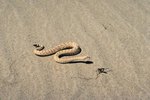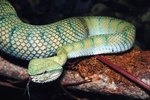
Snakes are present in all 50 U.S. states in great variety and diversity of species. There are several ways to differentiate one type of snake from another, but many display stripes as a prominent feature. Understanding how stripes can help you identify a snake -- and when they are an indicator of possible danger -- can help make the process a bit easier.
Venom
The most important reason for determining what species a snake may be is often the need to know if it's venomous or not. In the United States, there are several species of venomous snake that have vertical stripes or bands that help make them more easily identifiable. The coral snake has continuous rings of red, yellow and black along its body. The water moccasin or cottonmouth sometimes -- but not always -- has yellow bands of color stretching across a mostly brown or black body. The timber rattler also has an orange stripe down its back intermixed with the classic diamond pattern of the rattlesnake.
Analysis
The color, number, size, location and length of stripes are all clues used to identify snakes by their stripes. For example, the rainbow snake has three red stripes that run the length of its back, while the striped crayfish snake has two lightly colored stripes that run down its upper sides and a third yellow stripe that runs down its lower side. Another example of subtle differences can be found among the eastern black-neck garter, checkered garter, Texas brown and Texas lined snakes. All have a white or light-colored stripe running down the center of their backs, but differences in the surrounding patterns and stripe shades can help identify them from one another.
Underside
If the snake has stripes along its underside, the process of identification becomes far easier. There are only seven snakes in North America that have stripes on their undersides, the most dangerous being the southern copperhead, which is poisonous. The others are the banded water snake, mangrove salt marsh snake, plain blackhead snake, western blackhead snake, queen snake and lined snake.
Rhyme-Time
A traditional saying can help you identify dangerous striped coral snakes in a pinch when the adrenaline of an encounter eliminates your ability to recall all the facts you've learned. For example, try repeating "Red touches black, no worries for Jack. Red touches yellow, dangerous fellow." If the pattern on the snake's back has red rings touching yellow, avoid it at all costs.
References
Photo Credits
-
Ryan McVay/Digital Vision/Getty Images
Writer Bio
Robert Morello has an extensive travel, marketing and business background. He graduated with a Bachelor of Arts from Columbia University in 2002 and has worked in travel as a guide, corporate senior marketing and product manager and travel consultant/expert. Morello is a professional writer and adjunct professor of travel and tourism.




